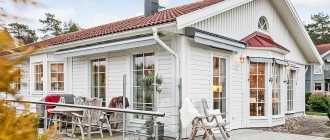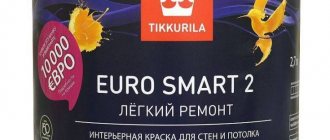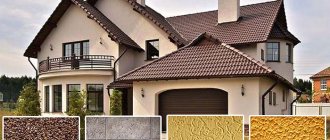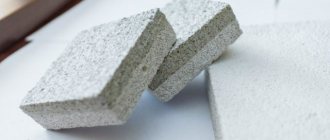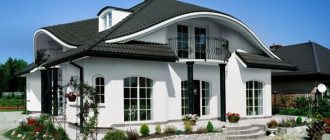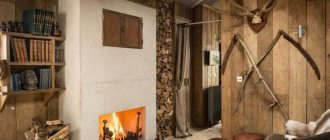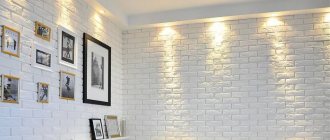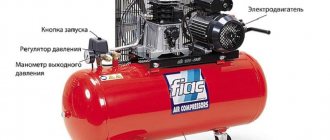Features of façade paint on wood
The process of painting houses built from wooden material differs only in that they require the use of special processing agents. The most important points that distinguish the usual technological process of painting a facade lie mainly in the preparatory work.
If the building is new, then before starting to prime the surface, it is treated with special solutions with anti-resin and antiseptic effects . This measure is necessary to prevent the release of resins from natural wood, as well as to provide additional protection to the wood from damage by insects and other pests.
As for the primer itself, the material is also chosen specifically for wooden surfaces. Otherwise, the entire process of painting a wooden house is quite simple. In addition, the process of painting a wooden house involves additional work to ensure the protective properties of the wall surface. Although there are also paints, using which there is no need to resort to any additional measures other than to complete the entire technological process.
CAREFULLY!
It is also very important to carry out the process of painting the facade of a wooden house in dry weather , and such weather conditions must persist for at least a week before starting work. This is necessary so that the façade of the house does not carry excess moisture.
Dulux Bindo Facade
See also
Stone wool for facade insulation: how to insulate walls from the outside
The brand belongs to the AkzoNobel concern (like Hammerite). Production has also been established in Russia.
It is based on latex emulsion and various additives that protect the facade from efflorescence, mildew and mold.
The main characteristics include:
- quick application;
- harmlessness;
- elasticity of the coating;
- tightness;
- vapor permeability;
- consumption is about 1 liter per 12-14 m2;
- suitable for various outdoor surfaces;
- It is better not to use indoors;
- washes well.
Dulux Bindo Facade
The price is low. The popular version of a 10-liter bucket will cost 3,800 rubles. That is, 380 rubles per 1 liter.
Advantages and disadvantages
Regarding the advantages that can be obtained from the use of paints and varnishes for finishing the facade of a wooden house, the following can be identified:
- The most important thing is to create an attractive appearance of the building (including the old covering) and the opportunity to implement the most diverse and original ideas for decorating your home. The choice of such materials on the construction market is very large, and allows you to purchase the desired type of paint;
- the materials have a high level of covering power and, when applied, create a dense and elastic layer;
- the color rendering of paints and varnishes is very good, characterized by richness and clear texture;
- after applying paints and varnishes intended for treating wooden surfaces, the façade of the house does not lose its breathable properties;
- a dried layer of paint provides protection to the structure not only from unexpected mechanical damage, but also prevents cracks from forming in the wood;
- The protective coating can prevent the accumulation of dirt particles , which greatly facilitates the process of maintaining the building.
For such materials, there are some disadvantages that depend on the component composition of some paints. Most materials have a high level of toxicity, so they are only allowed to be used in open areas . The price category of materials is quite high.
In addition, some types of paints are not able to maintain their original color for a long time; they darken or fade. However, the manufacturers of such materials have provided for this and a high-quality paint coating requires re-coating the building with paint.
What paints are used for exterior painting of a wooden house?
Facade paints differ primarily in the composition of film-forming components. And the type of solvent, the possibility of tinting and other parameters depend on them.
Antiseptics
Antiseptic impregnations are often used to treat the walls of a house. They can also rightfully be considered full-fledged paints. Antiseptics can be glazing and coating. Glazing antiseptics create a transparent coating that emphasizes the texture and color of the wood.
Coating antiseptics create an opaque coating on the surface, but preserve the texture of the wood.
Antiseptics are very convenient for covering facades made of planed or polished wood of valuable varieties, which have their own distinct pattern and beautiful texture. Antiseptics are good because they penetrate deeply into solid wood. The compounds dry very quickly and in most cases, for complete protection, it is enough to cover the wood with two layers of impregnation. But this treatment can only be performed on fresh wood that has not been painted before.
Antiseptic impregnation should be repeated once every 2 to 3 years. But there are expensive products that can be updated every 5-6 years. As a rule, they belong to the category of azures or colored impregnations and, together with the protective one, play a decorative role. Many impregnations include substances that block ultraviolet radiation; the wood does not darken or change color after such treatment.
Acrylic or acrylate paints
The most fashionable and modern paints for external decoration of facades. Produced in the form of emulsions and dispersions, water-soluble. In most cases, the basis of such paints is acrylic resins or acrylic copolymers. Artificial or natural rubbers, antiseptics and fungicides can be added to the components. They are sold in the form of a white or transparent base with varying degrees of gloss - matte, glossy, semi-gloss.
A number of pigments and dyes have been developed for acrylic paints, with which they can be tinted to any desired color and shade. Some dye catalogs contain up to 20,000 color solutions. But when purchasing such paint, it is advisable to choose a pigment from a fan of colors from the same manufacturer. Most factories keep the chemical compositions of their paints secret, so different reactions are possible between products of different brands.
Of course, there will be no explosion, but the paint will take too long to dry, will bubble, or will quickly fade and change color. To avoid such “surprises”, it is better to buy a product from the same brand or check the paint and pigment for compatibility. Most serious stores will tell you what you can mix with what. It’s best to tint the composition right in the store, this is especially convenient if there is a tint machine and a color studio.
Acrylic paints:
- provide a wide range of colors;
- have excellent adhesion to wood;
- have no odor;
- absolutely safe in terms of fire;
- environmentally friendly and non-allergenic.
But they have a significant drawback - they are quite expensive, at least significantly more expensive than alkyd and oil-based ones.
Alkyd paints
These are well-known compounds that have been used to paint wooden walls for many years. Paints created on the basis of polycondensation resins, united under the name “alkyds,” are characterized by relatively low production costs, excellent coating ability, and a high level of adhesion to wood. Moreover, you can paint both polished, planed or sawn wood, as well as logs from which the bark has just been removed.
Alkyd paints form a dense and durable highly elastic film that responds very well to temperature changes in wood and does not crack during drying, thermal expansion or other dimensional changes. When covering wood in two layers, the film becomes waterproof and slightly vapor permeable. Therefore, it is recommended to paint only dry wood with alkyd paints.
Some manufacturers include antiseptics and fire retardants in alkyd paints. You must find out about their presence from the instructions for the paint before using it. If there are no such components, then the walls need to be further processed before painting. This slightly increases the cost of painting, but the service life of the coating and the house as a whole increases several times.
Alkyd paints are usually available in a fixed range of colors, but changing the shade is quite simple - you need to mix two or more paints in a certain proportion so that the color changes in the desired direction. The quality of the finishing coating does not change. But, as in the case of acrylics, it is advisable to use only paints from the same manufacturer for mixing.
In recent years, the world's leading manufacturers have also offered colorless alkyd paints, which are tinted in the same way as acrylic ones. This is very convenient, especially when painting a new house, when the urgent question is how best to paint the outside of a wooden house so that it stands out among its neighbors, even those built according to the same design, which is often in cottage villages.
Alkyd paints are a full-fledged competitor to acrylic paints in terms of quality. They lose only in fire safety, and even then only during storage and operation - here they require compliance with fairly strict rules of conduct with fire and heating devices. But after drying, the paint layer becomes practically non-flammable. However, due to rapid drying, the paint does not have time to penetrate deeply into the wood, which negatively affects its durability. Alkyd paints have good frost resistance and can withstand temperatures below - 300C.
Solvents for paints based on alkyd resins are white spirit, solvent and similar weak organic solvents. They are moderately toxic and flammable, which also requires compliance with safety precautions when working. Although gasoline and kerosene also dilute alkyd paints well, their use is undesirable - the color fades somewhat, and the gloss may change towards becoming more matte.
Oil paints
For a long time, oil compositions, the diluent of which is drying oil or other natural oils, represented serious competition to alkyd ones. But in recent decades, an increasing number of manufacturers have abandoned them - the paints are quite difficult to use, take a long time to dry, and the characteristics of the finishing coating are inferior to most modern compositions.
Despite their shortcomings, these paints are the most budget option. Once applied to wood, the paint is perfectly absorbed and creates a weather-resistant coating.
Material properties
Materials intended for outdoor woodwork have certain properties that ensure a high level of quality:
- The materials help remove excess moisture , after which they provide a protective barrier that does not allow moisture to enter the wood structure.
- Paints help protect wooden surfaces from aging.
- The layer of material forms a special film that does not allow ultraviolet rays to destroy the structure of the wood , and also gives the wood strength, which allows cracks to not appear for as long as possible.
- After treatment with paints, the wood texture becomes more pronounced and attractive . This occurs due to the fact that the material penetrates into the smallest textured recesses in the wood and makes them more noticeable.
- Gives the facade of the building an attractive and aesthetic appearance.
VGT VDAK 1180
Domestic economy class product. Has a wide range of applications.
In 2013, paints from this manufacturer were used in the construction of the Fisht stadium (Sochi).
Characterized by the following features:
- affordable price;
- adequate level of quality;
- suitable for external and internal work;
- clings well to concrete, brick, plaster, as well as fiberboard, plasterboard and even wallpaper;
- work should be carried out at a temperature not lower than -10 degrees Celsius;
- long service life of the coating;
- The dye allows you to choose any desired color and shade.
Paint VGT VDAK 1180
At the same time, consider where you buy the paint. The quality may vary greatly from this.
A container with a volume of 7 kg will cost 600 rubles.
Types of materials
The variety of colors on the facade is quite large, but you should pay attention only to the most popular and popular options. Highlight:
- The transparent variety of wood paints contains only those pigments that can reveal the texture of wood . Transparent paints are characterized by a high level of vapor permeability, which enhances the ability of the wooden material to dry. The composition contains a substance that protects wood from the destructive effects of UV rays. Using this type of paint on wood involves treating the facade 1-3 times a year, and there is no need to remove the previous layer.
- Paints containing organic solvents. These include: acrylic, alkyd and polyurethane varieties. They are characterized by a high level of water-repellent ability and are resistant to sunlight, which allows the materials to retain their color for the longest possible time. If it is necessary to repeat the processing, it is necessary to remove the previous layer. Such paints and varnishes are characterized by high toxicity and the disadvantages include the ability to be subject to fire.
- The water-dispersion type is one of the most modern options for paints and varnishes for wooden facades . For the solvent in this type of paint, a water base is used, which evaporates after the material is applied. Thanks to this, the wooden facade acquires a high level of frost resistance. They are characterized by high vapor permeability and the ability to maintain light and color qualities for a long time.
- Oil paints contain drying oils, they are characterized by a very unpleasant odor, and they are not highly resistant to low temperatures and high humidity levels . The drying process for oil-based paints is very long. They are characterized by rapid wear, however, they hold on tightly. A distinctive feature of this material is the ability to carry out work at a lower temperature than the water-based variety allows.
Features of protective and decorative products based on acrylic dispersion
It is worth noting that all of the above products do not contain solvents, so they do not have a strong odor and are absolutely safe. And acrylic dispersion as a base is the key to the durability and practicality of coatings, since it is acrylic resins that provide vapor permeability and elasticity. Therefore, regardless of the type of product used, no cracking, peeling or peeling is guaranteed. Simply because all the unpleasant phenomena mentioned above happen precisely with paintwork materials, which form on the surface of wood not a film that can adapt to “moving” bases, which include natural wood, but a “crust”.
Another important property is that impregnation, paints, oils, and varnishes are easy to use, do not require special skills and can be applied in various ways. At the same time, no streaks, drops or streaks are formed during the application process, and the coating is uniform without excessive effort.
Universal floor paint
Manufacturing companies
The construction market presents a wide range of paints and varnishes for wooden facades from various manufacturers.
Mizar Universal
Mizar Universal paint, Russian manufacturer. This paint uses a special acrylic copolymer, which allows it to achieve a high degree of elasticity, water resistance and resistance to sunlight. Mizar Universal effectively prevents deformation and cracking of wooden material . And due to the vapor permeability of the coating, not only the evaporation of moisture from the wood is ensured, but also the necessary air exchange.
It should be noted that he has serious experience in the development of formulations and production of paints and varnishes with increased resistance to external influences. Thus, Mitsar products were used in the construction of the Leningrad and Kola nuclear power plants. Mitsar is a permanent manufacturer of paints and varnishes for State Defense Order enterprises . With similar or higher characteristics, coatings have the lowest price among competitors.
Other
Also among the most popular are the following:
- Made in the USA, Sherwin-Williams . This manufacturer uses the latest technologies, the analogues of which do not yet exist. Such paints and varnishes are characterized by self-priming and are capable of creating a high-quality coating in just one coat.
- Duration exterior acrylic LaTeX . The materials are equipped with a lifetime guarantee and have increased wear resistance. To cover the facade, it is enough to carry out a single layer of painting.
- Super exterior acrylic LaTeX company . The warranty on the paint is 25 years, and it is characterized by a distinctive feature that allows painting of a wooden facade at low temperatures.
- Russian production, Profi Tex paint. One of the most popular brands of paint and varnish coatings, which is characterized by an antibacterial effect and low cost.
- Paint made in Finland by Tikkurila, which can be used for finishing facades in low temperature conditions. It has a high level of protective properties against various adverse effects, its service life reaches 20 years. Gives the facade increased strength and protects against mechanical damage.
Acrylic paint GOST 28196-89: technical characteristics
According to GOST 28196-89, acrylic paints must fully comply with the following parameters:
- there should be no “wrinkles”, smudges or peeling on the dried surface;
- level of content of non-volatile components: 52-57% for water-dispersed formulations and 64-67% for solvent-based formulations;
- pH level: 6.5-9.5;
- hiding power: no more than 100 g/m2 for white and no more than 120 g/m2 for other colors;
- resistance to constant exposure to moisture under standard conditions: 24 hours;
- cold resistance: 5 cycles;
- resistance to light: no more than 5%;
- washability: no more than 2.5-3.5 g/m2;
- duration of operation: 10 years;
- drying time: 6-30 hours;
- grinding index: no more than 60 microns.
All of the above requirements are established by GOST, therefore all official manufacturers offer products that comply with these standards.
How to paint a wooden facade
What is the best paint for a wooden house? As for choosing the optimal paint and varnish material for a house, this question can only be answered by the owner himself, who knows all the nuances of the structure and the climatic conditions of the area. The most important thing is that the paint and varnish material meets all the necessary requirements and is able to provide protection to the facade.
IMPORTANT!
In most cases, the water-dispersed variety is best.
Another important feature of paints for wooden facades is the possibility of repainting the entire facade. Once you know the entire list of paint coating requirements, there will be no difficulties in purchasing a specific type of material. It is recommended to purchase material for finishing the facade with a small reserve, since in the future there will be a need to tint some fragments of the surface of wooden walls.
Caparol Muresko Premium
German paint with one of the best vapor permeability indicators.
A good choice if you need to treat a wooden facade. The mixture is made of acrylic and silicone components. The result is silacrylic.
The properties are as follows:
- combination of the advantages of acrylic and silicone;
- high moisture protection;
- resistance to efflorescence;
- apply only with a roller or brush;
- no smell;
- acceptable consumption rates;
- Possibility of application for different surfaces.
Caparol Muresko Premium
For 1 liter they will ask for at least 600 rubles.
Technological process of painting
Having decided on the type of paint, and having appointed the day on which the finishing will be carried out, it is necessary to go through the preparatory stage before the actual painting. It consists of cleaning the surface of the walls from the old paint and varnish coating, if any . To do this, use special solutions or a hair dryer.
If there are none, then the process can be carried out in the usual way, using a spatula or a wide chisel. As for the new structure, it is necessary to treat it with a solution with an anti-tar effect.
To prepare the surface of an old building, you will need to use putty, which will be used to repair the cracks and chips that have formed. After waiting for the material to dry completely, the areas covered with it are sanded.
Padding
This process begins with washing the walls using a soap solution. After waiting for the wooden facade to dry completely after washing, proceed directly to priming. For this process, a primer containing antiseptic substances is used.
This can protect the tree from water getting into it, which later leads to the formation of mold. After the primer has been applied, you must wait for it to dry completely and continue with the façade finishing.
IMPORTANT!
It is recommended to prime a wooden façade using a brush.
Basic painting work for a wooden house
The process of direct painting should begin only after several days, after priming the surface of the walls.
- Pre-unpack the paint and dilute it to the desired consistency . Depending on the type of materials, the appropriate solvent is used;
- then proceed to apply the first layer, using a brush for this;
- paint is applied to the façade using a roller or sprayer . This can be done either in a single layer or in two or three layers. It takes at least 4 hours to dry one layer of material.
NOTE!
It is advisable to carry out all work on painting the facade at a temperature ranging from - 5 to + 40 degrees.
Scope of application
Due to the high technical and operational properties, the unlimited scope of application of acrylic paints is not surprising. They can be used on almost all types of bases, be it wood, concrete, stone or metal, with the exception of some types of plasterboards, which greatly simplifies the choice of materials when carrying out finishing or repair work. In the line of any manufacturer there is always paint for interior and exterior work in a wide range of colors, therefore, there will be the same quality of the painted surface and matching shades during transitions.
When choosing, it is worth considering that there are universal paints in terms of bases, but within the group they usually differ in the specific application - for walls, ceilings and floors. This is due to a practical component - these zones have different operating conditions, and they look different due to the different angle of incidence of light. And the application technique is different, which determines the consistency and composition of the additives.
The popularity of acrylic paints is also explained by the atypical color range - while standard floor enamels are overwhelmingly brown, acrylic ones can be of any color.
Vlademir FORUMHOUSE Member
My wife wants floors at home that are not the color of traditional floor paint, but light, with a brownish tint, that is, as light as possible. Nearby stores offer acrylic flooring; the manufacturer's assortment includes a light color. Does anyone have experience?
Eat.
Nika19 Member of FORUMHOUSE
We painted with water-soluble acrylic, the color was a straw. It turned out to be light-light yellow, a nice shade, I also love light floors.
